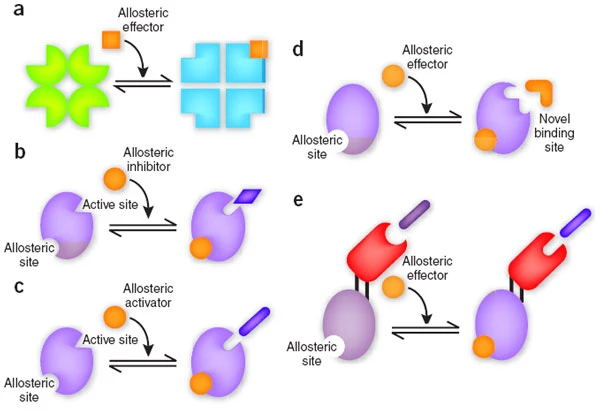Overview
Allosteric site modification is a powerful strategy in enzyme design that involves introducing targeted changes to the allosteric site of an enzyme to achieve desired regulatory effects. This approach allows for precise control over enzyme activity by modulating the binding affinity of allosteric effectors or altering the conformational dynamics of the enzyme.
 Fig. 1. Different modes of allosteric behavior. (Goodey, N.M.; S.J, Benkovic. 2008)
Fig. 1. Different modes of allosteric behavior. (Goodey, N.M.; S.J, Benkovic. 2008)
Our Services
- Identify Allosteric Sites for Modification
We possess a deep understanding of allosteric regulation and the role of allosteric sites in modulating enzyme activity. Through comprehensive analysis of the enzyme's structure, dynamics, and regulatory mechanisms, we identify potential allosteric sites that can be targeted for modification.
- Computational Modeling and Simulation
We employ advanced computational modeling and simulation techniques to explore the effects of allosteric site modifications on enzyme behavior. Through molecular dynamics simulations, binding affinity predictions, and network analysis, we gain insights into the allosteric communication pathways and the impact of site modifications on enzyme function.
- Rational Design Strategies
Based on the computational analysis and experimental data, we employ rational design strategies to modify the allosteric sites. This may involve site-directed mutagenesis, structural modifications, or the introduction of novel binding pockets to enhance the allosteric regulation of the enzyme. We carefully consider the desired outcomes and tailor the modifications to achieve specific goals, such as improved catalytic efficiency or altered substrate specificity.
- Binding Studies and Characterization
We conduct detailed biochemical and biophysical characterization to evaluate the effects of allosteric site modifications on enzyme behavior. This includes assessing binding kinetics, affinity, and cooperativity between the allosteric modulators and the enzyme. These studies provide valuable insights into the allosteric regulation mechanisms and help optimize the modified enzyme's performance.
- Enzyme Optimization and Engineering
Through an iterative design process, we optimize the enzyme's allosteric site modifications to achieve the desired functional outcomes. We consider feedback from the characterization studies to refine the design and ensure that the modified enzyme exhibits enhanced catalytic properties, substrate specificity, and regulatory control.
Advantages of Our Services
Our Allosteric Site Modification Services in enzyme design offer several distinct advantages that set us apart as a leading provider in the field. Here are the key advantages of our services:
- Enhanced Enzyme Function: Allosteric site modification allows us to fine-tune enzyme function by optimizing its catalytic activity, substrate specificity, and regulatory properties. Through targeted modifications, we can unlock hidden catalytic potential, improve enzymatic efficiency, and tailor enzyme behavior to specific requirements. This leads to enhanced performance and increased productivity in various applications.
- Precise Regulatory Control: Allosteric site modification enables precise control over enzyme activity through allosteric regulation. By strategically modifying allosteric sites, we can modulate the enzyme's response to different ligands, substrates, or environmental conditions. This fine-tuning of regulatory control allows for dynamic adjustments in enzyme behavior, providing flexibility and adaptability in complex biological systems or industrial processes.
- Customized Solutions: We understand that each enzyme and application is unique. Our services are highly customizable, allowing us to tailor the allosteric site modifications to meet specific goals and requirements. Whether you need improved catalytic efficiency, altered substrate specificity, or enhanced regulatory properties, we work closely with you to develop personalized strategies that address your specific challenges.
Our company offer a powerful approach to tailor enzyme function and regulation to specific needs. By strategically modifying allosteric sites, we can fine-tune enzyme behavior, unlock hidden catalytic potential, and optimize enzymatic processes for various applications. Please contact us and get our customized solutions to meet your objectives.
Reference
- Goodey, N.M.; S.J, Benkovic. Allosteric regulation and catalysis emerge via a common route. Nature Chemical Biology. 2008. 4(8): p. 474-482.

































 Fig. 1. Different modes of allosteric behavior. (Goodey, N.M.; S.J, Benkovic. 2008)
Fig. 1. Different modes of allosteric behavior. (Goodey, N.M.; S.J, Benkovic. 2008)